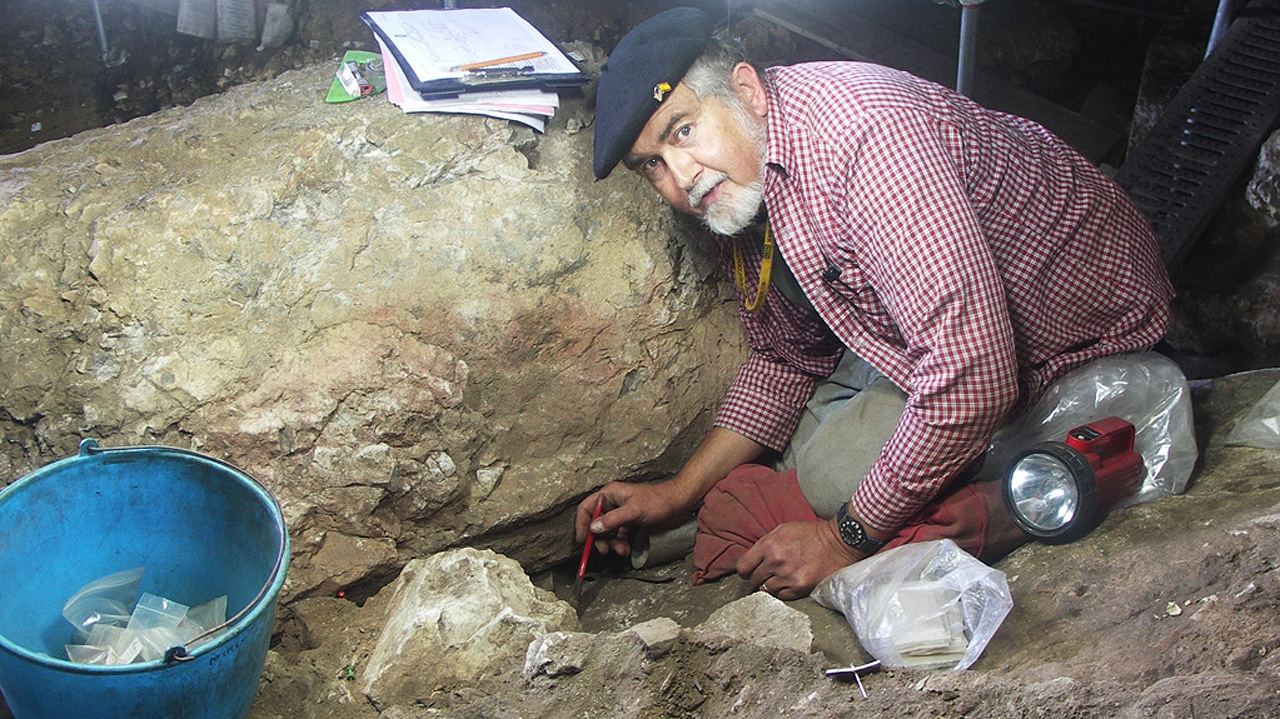Dr. Lawrence Straus presents THE RED LADY OF EL MIRÓN
-Event-

Start Date: Jan 21, 2020 - 07:30pm
Location: Albuquerque Museum of Art and History, 2000 Mountain Road NW
THE RED LADY OF EL MIRÓN
Lawrence Guy Straus
7:30 PM, Tuesday, January 21, 2020
Albuquerque Museum of Art and History
2000 Mountain Road NW
In 2012, my colleague Manuel González Morales and I presented a preliminary report on the discovery of a human burial in Lower Magdalenian context in El Mirón Cave in Cantabria, Spain at the Paleoanthropology Society Meeting. A monographic issue of the Journal of Archaeological Science was dedicated to this burial in 2015 and, in 2016, an article was published in Nature. It documents the DNA evidence developed in laboratories at the Max Planck Institute in Germany and at Harvard University in the US that this human’s genetic makeup confirmed the archaeological evidence for a Last Glacial Maximum refugium in southwest Europe from which humans re-expanded northward during the Magdalenian period. Originally interpreted as a secondary burial, the “Red Lady” is now understood to be an 18,800-year-old, disturbed primary interment from which certain major elements (the cranium and most long bones) had been removed, possibly as part of rituals that did not end with the original burial. Still-ongoing multidisciplinary analyses of this rare burial (unique for the Magdalenian of the Iberian Peninsula, but similar to semi-contemporaneous ones in France) include: osteological and dental studies of the remains to determine age and sex; physical and health status; dental residue studies on diet (mixed meat and plant); the presence or absence of infectious pathogens (absence); and determination of ancient DNA. In addition, there have been archaeological studies of the grave: artifactual and faunal contents of its infilling; its proximity to rock art engravings and pigment staining (possibly marking the grave); and mineralogical determination of the exact, non-local sources of the specially-prepared hematite ochre used to stain the clothing and the body and/or bones of the deceased, as well as the adjacent block and cave wall. It is apparent that this robust, apparently healthy 35- to 40-year-old female was given unusual and very special treatment after death that involved considerable investment on the part of the social group of which she had been an important member. The “Red Lady” of El Mirón joins the adult women buried in three French Magdalenian sites; only one other buried Magdalenian-age skeleton whose sex could be determined was an adult male from the French Laugerie-Basse site. Either this is a coincidence or the presumed special status of “men the hunters” is overrated.
Lawrence Straus is Leslie Spier Distinguished Professor Emeritus of Anthropology at the University of New Mexico where he has served since 1975. He received his PhD in Anthropology from the University of Chicago, where he also obtained his AM and AB (Honors) degrees. His dissertation was on the 25,000-to-20,000-year-old Solutrean culture of Cantabrian Spain, and he is a specialist in the Upper Paleolithic of Western Europe. He has directed/co-directed excavations in Spain, France, Portugal, and Belgium. His archaeological fieldwork has spanned most of the late Quaternary period, from the Middle Paleolithic through the Bronze Age, especially the Magdalenian (20,000 to 14,000 years ago).
Straus is the author or editor of 23 books, special journal issues, and monographs, and author/co-author of over 600 journal articles, chapters in edited volumes, and reviews. He is the US representative on the Union Internationale des Sciences Préhistoriques et Protohistoriques Commission on the Upper Paleolithic of Eurasia and past president of the International Union of Quaternary Research (INQUA) Commission on Human Evolution & Paleoecology, a former member of the US National Committee for INQUA, having been appointed three times by the US National Academy of Science. Straus has been Editor-in-Chief of UNM’s 75-year-old, internationally renowned Journal of Anthropological Research since 1995. His research has been funded by numerous grants from the National Science Foundation, Leakey Foundation, National Geographic Society, Fundación Botín, University of New Mexico, and the Spanish and Cantabrian governments.
Straus is perhaps best known recently for the discovery and study of the “Red Lady of El Mirón,” a 19,000-year old human burial in highly ritualized context, published as a special issue of the Journal of Archaeological Science. In 2016, Straus delivered the Annual Research Lecture, the highest honor bestowed on a faculty member by the University of New Mexico. He has given guest lectures at Harvard, Stanford, Chicago, Indiana, Arizona State, and several European universities and museums, and at the Smithsonian Institution and Oregon Museum of Science. Straus has been a visiting professor at several universities in Spain, Croatia, and Argentina. Symposia were held (and corresponding books published) in honor of his retirement at the Annual Meeting of the SAA in Orlando and at the III International Meeting on the Solutrean in Faro, Portugal. Straus’s French grandfather and great-grandfather were amateur prehistorians in southwest France, and as a teenager he got his start in archaeology with the New Hampshire Archaeological Society. His wife, Mari Carmen, and daughter, Eva, are “montañesas” from Cantabria.
